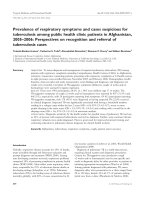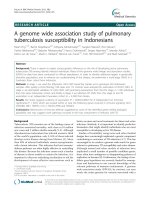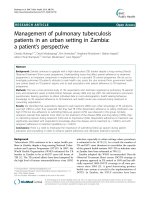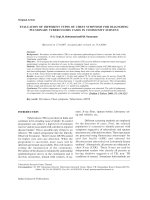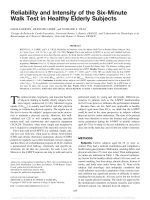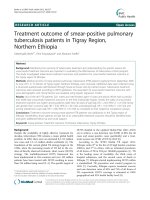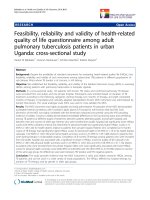Feasibility, reliability and validity of health-related quality of life questionnaire among adult pulmonary tuberculosis patients in urban Uganda: cross-sectional study docx
Bạn đang xem bản rút gọn của tài liệu. Xem và tải ngay bản đầy đủ của tài liệu tại đây (438.94 KB, 8 trang )
RESEARC H Open Access
Feasibility, reliability and validity of health-related
quality of life questionnaire among adult
pulmonary tuberculosis patients in urban
Uganda: cross-sectional study
Harriet M Babikako
1*
, Duncan Neuhauser
2
, Achilles Katamba
3
, Ezekiel Mupere
4
Abstract
Background: Despite the availability of standard instruments for evaluating health-related quality life (HRQoL), the
feasibility, reliability, and validity of such instruments among tuberculosis (TB) patients in different populations of
sub-Saharan Africa where TB burden is of concern, is still lacking.
Objective: We established the feasibility, reliability, and validity of the Medical Outcomes Survey (MOS) in assessing
HRQoL among patients with pulmonary tuberculosis in Kampala, Uganda .
Methods: In a cross-sectional study, 133 patients with known HIV status and confirmed pulmonary TB disease
were recruited from one public and one private hospital. Participants were enrolled based on duration of TB
treatment according to the following categories: starting therapy, two months of therapy, and eight completed
months of therapy. A translated and culturally adapted standardized 35-item MOS instrument was administered by
trained interviewers. The visual analogue scale (VAS) was used to cross-validate the MOS.
Results: The MOS instrument was highly acceptable and easily administered. All subscales of the MOS demonstrated
acceptable internal consistency with Cronbach’s alpha above 0.70 except for role function that had 0.65. Each
dimension of the MOS was highly correlated with the dimension measured concurrently using the VAS providing
evidence of validity. Construct validity demonstrated remarkable differences in the functioning status and well-being
among TB patients at different stages of treatment, between patients attending public and private hospitals, and
between men and women of older age. Patients who were enrolled from public hospital had significantly lower HRQoL
scores (0.78 (95% confidence interval (CI); 0.64-0.95)) for perceived health but significantly higher HRQoL scores (1.15
(95% CI; 1.06-1.26)) for health distress relative to patients from private hospital. Patients who completed an 8 months
course of TB therapy had significantly higher HRQoL scores for perceived health (1.93 (95% CI; 1.19-3.13)), health distress
subscales (1.29 (95% CI; 1.04-1.59)) and mental health summary scores (1.27 (95% CI; 1.09-1.48)) relative to patients that
were starting therapy in multivariable analysis. Completion of 8 months TB therapy among patients who were recruited
from the public hospital was associated with a significant increase in HRQoL scores for quality of life subscale (1.26
(95% CI; 1.08-1.49)), physical health summary score (1.22 995% CI; 1.04-1.43)), and VAS (1.08 (95% CI; 1.01-1.15)) relative
to patients who were recruited from the private hospital. Older men were significantly associated with lower HRQoL
scores for physical health summary score (0.68 (95% CI; 0.49-0.95)) and VAS (0.87 (95% CI; 0.75-0.99)) relative to women
of the same age group. No differences were seen between HIV positive and HIV negative patients.
Conclusion: The study provides evidence that the MOS instrument is valid, and reliably measures HRQoL among
TB patients, and can be used in a wide variety of study populations. The HRQoL differed by hospital settings, by
duration of TB therapy, and by gender in older age groups.
* Correspondence:
1
School of Public Health, College of Health Sciences, Makerere University
P O Box 7072 Kampala, Uganda
Full list of author information is available at the end of the article
Babikako et al. Health and Quality of Life Outcomes 2010, 8:93
/>© 2010 Babikak o et al; license e BioMed Central Ltd. This is an Open Access article distributed under the terms of the Creative
Commons Attribution License ( which permits unrestricted use, distribution, and
reprodu ction in any medium , provided the original work is properly cited.
Background
In Uganda, the estimated overall tuberculosis (TB) inci-
dence is 411 cases per 100,000 population and ranks
16
th
among the 22 high-burden countries for TB. The
Uganda TB treatment success (68%) is far below the
WHO target of 85% [1,2]. A comprehensive understand-
ing of barriers to and facilitators of poo r TB treatment
outcome is still lacking, and this is a major obstacle to
finding effective solutions. The current TB program ser-
vices and clinical research have focused on outcomes of
mortality and microbiologic cure, and have neglected
patient’s preferences such as patient’s perceived health-
related quality of life (HRQoL) which may be crucial in
influencing treatment outcome. Health-related quality of
life involves assessing a person’ s perception of his or her
physical and mental health [3]. Both physical and mental
distress is common in TB patients leading to poor dis-
ease outcome or poor treatment outcome because of
decreased ability to take treatment [4,5]. Kno wing
patient’s HRQoL would enable program managers and
clinicians to understand the functioning and well being
of TB patients so that individual patient specific needs
are addressed to attain the best clinical or treatment
outcome, and thus increasing the likelihood of adequa te
case management in TB programs.
Despite the availability of standard instruments for
assessing HRQoL [6-8], the feasibility; reliability; and
validity of such instruments among TB patients in dif-
ferent populations of sub-Saharan Africa, where the bur-
denofTBisofconcern,isstill limited. This paper fills
in this gap with results from a cross-sectional study that
evaluated HRQoL among adult TB patients attending
public and private program clinics in Kampala, Uganda.
We hypothesized: 1) that HRQoL would be better
among patients who have been longer on TB therapy
than patient s starting therapy; 2) that HRQoL would be
better among patients attending private hospital com-
pared to public hospital; 3) that HIV negative patients
and 4) women would have better HRQoL compared to
HIV positive patients and men, respectively.
Methods
Design and Setting
We conducted a cross-sectional study between November
2007 and Apri12008 to validate the HRQoL instrument
among TB patients. The study centers were Mulago TB
treatment center, located at the national teaching hospital,
Mulago; and Mengo TB clinic, located at Mengo mission-
ary hospital. Mulago a public hospital and Mengo a private
hospital were chosen to achieve patient heterogeneity in
the study population, and t o understand how patient
HRQoL differs by hospital setting. In addition, Mulago
hospital was chosen because it serves the largest number
of TB patients in Kampala, the capital city. Mengo hospital
was conveniently chosen to represent the private mission-
ary hospitals in Kampala city. The Mulago TB treatment
center is the principal facility that provides in-patient and
outpatients TB care in Kampala city. It has a bed capacity
of about 100 beds. The Mulago treatment center registers
more than 150 new TB patients a month while Mengo
registers about 30.
All TB patients are provided with an opt-out option
for HIV counseling and testing at the two hospitals.
Identification of TB patients in both treatment centers
is by passive case-finding as recommended by the
Uganda National Tuberculosis and Leprosy Program
(NTLP). P assive case-finding is self-referral of sympto-
matic individuals to health facilit ies. The main diagnos-
tic method is sputum microscopy with two positive
alcohol-fast bacilli (AFB) smear test or one positive
smear test with suggestive chest X- rays findings. During
care under t he Uganda NT LP guideline rec ommenda-
tion [9], patients in this study received short course
chemotherapy with daily Rifampicin, Isoniazid, Pyrazina-
mide, and Ethambutol (RHZE) for 2 months and during
the co ntinuation phase of 6 months wit h Isoniazid and
Ethambutol (EH).
The protocol was approved by the Faculty of Medi-
cine, Research Ethics Committee and the Uganda
National Council for Science and Technology. Partici-
pants provided written consent.
Subjects
Study participants18 or more years of age and identified
to have confirmed new TB disease at Mulago and at
Mengo TB treatment centers were eligible for recruit-
ment into the study. Participants were consecutively and
conveniently enrolled according to the following cate-
gories: starting TB treatment, completing two months of
treatment, and completing eight months of treatment.
Participants residing outside Kampala district or residing
beyond 20 kilometers from the treatment centers were
excluded. All participants spoke the local language-
Luganda.
Procedures
Identification of eligible par ticipants and administration
of the questionnaires were conducted by two study
nurses. The study nurses administered the question-
naires in face-to-face interviews after the pa tient exited
the pharmacy unit. The study questionnaires measured
HRQoL, HIV status, and socio-demographic informa-
tion. The study nurses were not involved in the routine
care of patients at the individual clinics. Patient’sHIV
sero-status was obtained verbally from the individual
patient and later confirmed with hospital records. Each
Babikako et al. Health and Quality of Life Outcomes 2010, 8:93
/>Page 2 of 8
participant was reimbursed with lunch valued at $1.50
after the interview. Data were double-entered using Epi-
Data version 3.1 2008 [10].
The Medical Outcome Survey (MOS) was used to
measure HRQoL among TB patients [11]. The MOS
questionnaire had been previously translated and cultu-
rally adapted in Uganda among HIV-in fected individuals
[7]. The MOS results were validated using the visual
analogue scale (VAS) [12,13]. We used the MOS
because it has b een shown to have good internal relia-
bility in a wide variety of settings, an excellent discrimi-
nant and convergent validity of the subscales [11,14],
and good physical and mental health summary scores in
HIV disease [7,15]. The MOS survey consists of 35
questions which assess ten dimensions of health includ-
ing general health perceptions, pain, physical function-
ing, role function, social functioning, mental health,
energy/fatigue, cognitive function, health distress and
quality of life (QoL). One of the items assesses health
transition [11]. For each of the MOS subscales,
responses to individual questions were aggregated and
scores were converted to a 0-to-100 point scale, with
100 representing the best health status or function . Phy-
sical (PHS) and mental health (MHS) summary scores
were calculated according to standard guidelines [15] to
have a mean of 50 and a standard deviation of ten.
The 100 c m “feeling thermometer” was used for the
visual analogue scale (VAS ). Patients indicate their self-
perceived quality of life for the day from 0 for the poor-
est imaginable state to 100 for the best imaginable
health state. The interviewer first revie wed the inter val
properties of the scale then asked the participant to
locate the health state on a 100-point scale.
Statistical analyses
The feasibility of conducting quality of life interviews
among TB patients using the MOS in urban Uganda
setting was evaluated by examining the percent of miss-
ing item responses, interviewer-reported acceptability,
and the time and ease o f administration. Cronbach’s
coefficient was cal culated to estimate reliability for
multi-item scales. In general, coefficient ≥ 0.70 indicates
satisfactory reliability [16]. Pearson coefficients were
used to correlate respondent’ sevaluationsoftheirown
health states using the VAS and MOS.
The construct validity of HRQoL scores was evaluated
in four ways: 1) t he researchers hypothesized that there
would be differences in the magnitude of the scores for
patients starting TB therapy, completing two months on
therapy, and those with completed therapy; 2) there
would be differences in the magnitude of the scores for
patients accessing public care services at Mulago and
private care services at Mengo hospitals; 3) there would
be differences in magnitude of the scores for HIV
positive and HIV negative TB patients; and 4) there
would be differences in magnitude of the scores for men
and women. Differences between group means of the
scores were compared using Wilcoxon-Mann Whitney
test due to lack of normality for the scores and reduced
power in subgroup analysis. Bonferroni corrections were
used to adjust for multiple comparisons and a p-value
of <0.008 was taken as significant. We adjusted for sex,
HIV status, age and hosp ital setting. Differences in pro -
portions were tested for using chi-square test.
The effect of variables such as hospital setting, sex,
HIV sero-status, and age group on HRQoL score s of the
MOS subscales and summary scales were calculated.
The effect was calculated using multiple linear regres-
sion analysis. The scores for HRQoL of all the subscales
were skewed. Therefore, a logarithmic transformation
was used to make the data more normally distributed.
Relative HRQoL scores by the exponential of regression
coefficients from multiple regression analysis were esti-
mated. We evaluated two-way interactions between sex
and age group, patient category, or hospital setting; and
between hospital setting and patient category. A p-value
of less than 0.05 was considered statistically significant.
All analysis was performed using SAS software version
9.2 (SAS Institute Inc., Cary, NC; 2004).
Results
Patient characteristics
Of the 133 participants who were enrolled into the
study, 67 were recruited from the public (Mulago) and
66 from the private (Mengo) hospital (Table 1). Further,
46 were starting TB treatment, 44 had completed two
months on treatment, and 43 had completed a full
course of 8 months treatment. The male to female ratio
was 1:1, similarly, HIV positive to HIV negative TB
patients. Four patients (3%) were of unknown HIV sta-
tus. There were no differences in mean age, in propor-
tions of men, and in proportions of patient categories
(i.e., starting TB therapy, two months on therapy, and
eight months on therapy) between patients who were
enrolled from public and private hospitals (Table 1).
Feasibility and reliability testing
There were few missing responses to the MOS; less than
1% (1/133) of the participants had missing responses for
any items. The MOS t ook approximately 13 minutes to
complete and was generally well tolerated by the partici-
pants. Interviewers reported that respondents had no
difficulty understanding concepts of the MOS items.
Cronbach’ s alpha coefficients for all subsca les were
>0.70 except for role function that had 0.65 (Table 2 ),
suggesting satisfactory internal reliability in general. All
MOS subscales correlated highly with the VAS scores
(Table 2).
Babikako et al. Health and Quality of Life Outcomes 2010, 8:93
/>Page 3 of 8
Health-related quality of life scores
In general, all scores of the MOS subscales and VAS
increased as the patients’ duration of TB treatment
increased (Figure 1). Patients with completed T B ther-
apy had the highest magnitude of HRQoL scores regard-
less of the M OS subscale com pared to patie nts starting
or patients that had completed two months of therapy.
For example, perceived health scores were 33.6 ± 27.7
among patients starting TB t herapy, 37.7 ± 27.2 among
patients with two completed months of therapy, and
43.8 ± 23.6 among patients with completed 8 months of
therapy while the VAS sc ores were 60.7 ± 11.9, 67.1 ±
13.6, and 78.5 ± 12.8, respectively.
Of all the MOS subscales, perceived health, bodily
pain, quality of life, and role function had the lowest
scores (Figure 1). When multiple comparisons were
made, we found significant differe nces in HRQoL scores
between patients starting therapy and patients who h ad
completed 8 months course of TB therapy for QoL
(41.8 ± 29.4 versus 62.5 ± 2 6.1; p = 0.001), mental
health (61.6 ± 25.5 versus 76.9 ± 20.8; p = 0.003), and
health transition (60.9 ± 29.2 versus 81.3 ± 26.5; p =
0.002) MOS subscales; men tal health summary score
(60.5 ± 21.6 versus 73.4 ± 17.4; p = 0.006); and visual
analogue scale (60.7 ± 11.9 versus 77.9 ± 13.3;
p < 0.001), respectively (Figure 1).
Patients who were recruited at the public hospital had
significantly lower scores of perceived general health
(31.4 ± 18.2 versus 45.2 ± 31.4; p = 0.014) and VAS
(65.0 ± 13.9 versus 72.2 ± 14.6; p = 0.004) compare d to
patients who were recruited at the private hospital,
respectively (Table 3). For al l the MOS subscales and the
VAS, there were no significant diff erences between men
and women, and between HIV positive and HIV negative
TB patients (Table 3). A similar relationship was found
in univariate linear regression analysis (Table 4).
In multivariable analysis after adjusting for sex, HIV
status, age, and patient category, patients who were
enrolled from the public hospital had significantly lower
HRQoL scores for perceived health (0.78 (95% confi-
dence interval (CI); 0.64-0.95)), quality of life (0.84 (95%
CI; 0.77-0 .92)), and VAS subscales (0.92 (95% CI; 0.92-
0.96)) relative t o patients from the private hosp ital
(Table 4). However, patients from the public hospital
had significantly higher HRQoL scores (1.15 (95% CI;
1.06-1.26)) for health distress relative t o patients from
the private hospital. Patient s who completed an
8 months course of TB therapy had significantly higher
HRQoL scores for perceived health subscale (1.93 (95%
CI; 1.19-3.13)), health distress subscale (1.29 (95% CI;
1.04-1.59)) and mental health summary scores (1.27
(95% CI; 1.09-1.48)) relative to patients that were start-
ing therapy.
Further in multivariable analysis (Table 4), patients
who completed 8 months of TB therapy among patients
who were recruited from the public hospital had a sig-
nificant increase in HRQoL scores for QoL subscale
(1.26 (95% CI; 1.08-1.49)), physical health summary
score (1.22 (95% CI; 1.04-1.43)), and visual analogue
scale ( 1.08 (95% CI; 1.01-1.15)) r elative to patients who
were recruited from the private ho spital and had
Table 1 Characteristics of 133 tuberculosis study
participants in Kampala, Uganda, 2007-2008
Characteristics Public hospital
(n = 67)
Private hospital
(n = 66)
Sex
Men (%) 34 (51) 33 (50)
Women (%) 33 (49) 33 (50)
HIV-serostatus
1
Positive (%) 32 (49) 32 (50)
Negative (%) 33 (51) 32 (50)
Mean age
(years) SD
2
32.0 ± 9.9 35.2 ± 11.2
Patient
category
Starting
therapy (%)
24 (36) 22 (33)
Two months on
therapy (%)
21 (31) 23 (35)
Completed
therapy (%)
22 (33) 21 (32)
Proportions were compared using chi-square test and means using Wilcoxon-
Mann Whitney; none was signi ficant.
1
Four patients were of unknown HIV
status.
2
Values are means with ± standard deviation.
Table 2 Reliability of the Medical Outcomes Survey
involving 133 tuberculosis participants in Kampala,
Uganda, 2007-2008
Subscale Number of
items
Cronbach’s
a
Correlation with VAS
score
a
Perceived
health
5 0.81 0.48
Bodily pain 2 0.88 0.46
QoL 1 -
2
0.47
Role
functioning
2 0.65 0.42
Social
functioning
1
1-
2
0.49
Vitality 4 0.89 0.48
Mental health 5 0.90 0.47
Health distress 4 0.96 0.40
Cognitive
function
4 0.88 0.35
Physical
functioning
6 0.89 0.46
Health
transition
1-
2
0.38
a
All Medical Outcomes Survey subscales had a correlation p-value <0.001.
1
One individual missed social function response.
2
Internal consistency
reliability cannot be calculated for a single-item scale.
Babikako et al. Health and Quality of Life Outcomes 2010, 8:93
/>Page 4 of 8
completed 8 mont hs of TB therapy. Men of 35 to 44
years in age were associated with significantly lower
HRQoL scores f or physical health su mmary score (0.68
(95% CI; 0.49-0.95)) and visual analogue scale (0.87
(95% CI; 0.75-0.99)) relative to women of the same age
group. For the QoL scores for HIV positive relative
to HIV negative pa tients were not significantly different
for all the MOS subscales and the VAS scale (Tables 3
and 4).
Discussion
We performed the feasibility and reliability of the MOS to
measure HRQoL among HIV positive and HIV negative
patien ts with pulmonary TB receiving care at publi c and
Table 3 Medical Outcomes Survey subscales and mean HRQoL scores among 133 tuberculosis participants in Kampala,
Uganda, 2007-2008
Hospitals (n = 133) Gender (n = 133) HIV status (n = 129)
1
MOS Subscale Public
(n = 67)
Private
(n = 66)
Men
(n = 67)
Women
(n = 66)
HIV sero-positive
(n = 64)
HIV sero-negative
(n = 65)
Perceived health 31.4 ± 18.2 45.2 ± 31.4
b
40.8 ± 27.1 35.6 ± 25.6 41.3 ± 26.6 36.3 ± 26.4
Bodily pain 62.4 ± 28.5 55.0 ± 26.2 60.4 ± 29.0 57.0 ± 26.2 58.6 ± 28.5 59.0 ± 27.2
Quality of life 53.7 ± 20.5 54.5 ± 34.2 53.7 ± 27.6 54.5 ± 28.7 55.1 ± 26.8 55.4 ± 28.8
Role functioning 52.2 ± 45.6 60.6 ± 39.7 59.0 ± 43.5 53.8 ± 42.3 55.5 ± 44.6 57.7 ± 41.7
Social functioning 74.0 ± 33.0 70.6 ± 29.2 72.8 ± 31.7 71.8 ± 30.8 71.9 ± 31.6 72.0 ± 31.4
Vitality 62.1 ± 19.9 62.7 ± 24.6 63.6 ± 23.5 61.1 ± 21.0 62.8 ± 22.6 61.9 ± 22.3
Mental health 73.4 ± 19.8 67.9 ± 22.4 71.4 ± 23.9 70.0 ± 22.8 72.1 ± 24.3 69.5 ± 22.7
Health distress 84.2 ± 21.4 69.5 ± 30.8
b
79.3 ± 26.5 74.4 ± 28.3 77.7 ± 27.5 76.1 ± 28.0
Cognitive function 86.0 ± 18.2 85.6 ± 17.4 84.5 ± 18.9 87.2 ± 16.4 83.2 ± 19.3 88.2 ± 16.1
Physical functioning 75.5 ± 20.3 71.8 ± 27.6 76.5 ± 24.0 70.8 ± 24.3 74.3 ± 23.4 73.8 ± 23.9
Health transition 71.3 ± 23.9 76.5 ± 30.0 72.8 ± 27.1 75.0 ± 27.4 75.8 ± 24.8 73.1 ± 29.7
PHS 65.4 ± 21.3 64.3 ± 25.1 67.0 ± 24.1 62.8 ± 22.2 65.1 ± 24.1 65.0 ± 22.4
MHS 67.8 ± 14.7 66.9 ± 24.8 68.2 ± 20.5 66.5 ± 20.2 68.3 ± 21.5 66.8 ± 19.7
Visual analogue scale 65.0 ± 13.9 72.2 ± 14.6
b
69.1 ± 16.1 68.0 ± 13.1 67.6 ± 14.7 69.8 ± 14.9
1
Four were of unknown HIV status;
b
p-value <0.05. MOS = Medical Outcome Survey, HRQoL = Health-related quality of life. Comparisons were made using
Wilcoxon-Mann Whitney test.
Figure 1 Health-related quality life scores among adult tuberculosis patients in Kampala Uganda, 2007-2008. Whiskers are standard errors
(SEs) whereas bars represent health-related quality of life (HRQoL) scores for eleven subscales and two summary scores of the 35-item Medical
Outcomes Survey (MOS) questionnaire; and HRQoL scores for the visual analogue scale (VAS) that was used to validate the MOS. The HRQoL scores
were evaluated among patients starting, completing two months, and completing 8 months tuberculosis therapy. The eleven subscales of the MOS
included general health perceptions, pain, quality of life, role function, social functioning, vitality (energy/fatigue), mental health, health distress,
cognitive function, physical functioning, and health transition. The MOS summary scores included physical and mental health summary scores.
Babikako et al. Health and Quality of Life Outcomes 2010, 8:93
/>Page 5 of 8
private hospitals in urban, Uganda. The key finding in this
study of 133 patients with pulmonary TB is that the MOS
in measuring HRQoL performed well on the psychometric
indicators and this instrument appears to be an effective
tool for evaluating HRQoL among TB patients. The scale
demonstrated acceptable internal consistency among TB
patients with different stages of treatment. Evaluatio n of
constructs revealed remarkable differences in the func-
tional status and well-being among TB patients at different
stages of treatment, hospital settings, and gender. How-
ever, no differences were seen by HIV status.
Findings in this study suggest that TB pati ents have
poor HRQoL at the time of diagnosis and this impres-
sion appear to be marked among patients attending
Table 4 Relative Medical Outcomes Survey HRQoL scores involving 133 tuberculosis participants in Kampala, Uganda,
2007-2008
Selected MOS Health-
related quality of life
subscales
variables
Hospital Sex HIV
status
Patient category Age group Interactions
Public Men HIV
positive
Two mo
therapy
Complete 8
mo therapy
25-34
yrs
35-44
yrs
45+yrs Male*35-
44 yrs
Public*8
mo therapy
Perceived health Univariate 0.76
(0.62-
0.92)
1.32
(0.88-
1.99)
1.14
(0.75-
1.72)
1.01 (0.65-
1.56)
1.62 (1.06-
1.22)
0.82
(0.53-
1.25)
1.22
(0.76-
1.97)
1.84
(1.05-
3.22)
Multivariate 0.78
(0.64-
0.95)
1.34
(0.90-
2.00)
0.90
(0.58-
1.39)
1.43 (0.88-
2.32)
1.93 (1.19-
3.13)
1.18
(0.68-
2.05)
1.50
(0.80-
2.81)
2.02
(0.98-
4.15)
R-square 17%
Quality of life Univariate 0.90
(0.83-
0.98)
0.94
(0.79-
1.12)
1.02
(0.86-
1.21)
1.18 (0.99-
1.41)
1.32 (1.12-
1.58)
0.96
(0.81-
1.14)
0.96
(0.79-
1.18)
1.08
(0.85-
1.38)
Multivariate 0.84
(0.77-
0.92)
0.99
(0.86-
1.16)
0.97
(0.82-
1.14)
1.48
(1.25-
1.78)
1.24 (0.96-1.60) 0.99
(0.80-
1.22)
0.92
(0.23-
1.17)
1.10
(0.83-
1.46)
- 1.26 (1.08-
1.49)
R-square 31%
Health distress Univariate 1.15
(1.06-
1.26)
1.09
(0.91-
1.31)
1.02
(0.85-
1.22)
1.04 (0.86-
1.26)
1.16 (0.96-1.41) 1.11
(0.91-
1.34)
0.93
(0.76-
1.15)
0.99
(0.78-
1.27)
Multivariate 1.16
(1.06-
1.26)
1.10
(0.92-
1.32)
1.00
(0.82-
1.21)
1.21 (0.97-
1.49)
1.29 (1.04-
1.59)
1.14
(0.89-
1.45)
1.00
(0.76-
1.32)
1.10
(0.80-
1.50)
R-square 13%
Physical health
summary score
Univariate 1.02
(0.94-
1.09)
1.05
(0.90-
1.22)
0.99
(0.85-
1.15)
1.07 (0.97-
1.25)
1.14 (0.97-1.33) 1.04
(0.90-
1.22)
0.99
(0.84-
1.17)
0.90 (90-
1.09)
Multivariate 0.95
(0.87-
1.03)
1.22
(1.03-
1.45)
0.98
(0.83-
1.15)
1.18 (0.99-
1.41)
1.03 (0.81-1.30) 1.00
(0.81-
1.23)
1.15
(0.87-
1.52)
0.89
(0.68-
1.16)
0.68
(0.49-
0.95)
1.22 (1.04-
1.43)
R-square 15%
Mental health
summary score
Univariate 1.04
(0.97-
1.11)
1.03
(0.90-
1.16)
1.01
(0.90-
1.15)
1.04 (0.91-
1.19)
1.16 (1.02-
1.33)
1.05
(0.92-
1.20)
0.96
(0.84-
1.12)
1.01
(0.85-
1.20)
Multivariate 1.04
(0.98-
1.11)
1.04
(0.91-
1.18)
1.00
(0.87-
1.15)
1.18
(1.01-
1.32)
1.27 (1.09-
1.48)
1.08
(0.90-
1.29)
0.99
(0.81-
1.21)
1.05
(0.84-
1.32)
R-square 9%
Visual analogue
scale
Univariate 0.95
(0.91-
0.98)
1.01
(0.93-
1.08)
0.97
(0.90-
1.04)
0.92 (0.90-
1.05)
1.24 (1.16-
1.32)
1.03
(0.96-
1.12)
0.93
(0.86-
1.01)
1.00
(0.90-
1.11)
Multivariate 0.92
(0.89-
0.96)
1.08
(1.01-
1.16)
0.99
(0.92-
1.05)
1.11
(1.03-
1.19)
1.22 (1.10-
1.34)
1.00
(0.92-
1.09)
0.98
(0.87-
1.09)
0.94
(0.84-
1.05)
0.87
(0.75-
0.99)
1.08 (1.01-
1.15)
R-square 41%
The following were reference groups: private hospital, women, HIV negative, starting treatment patient category, and 18-24 years age group. MOS = Medical
Outcomes Survey, HRQoL = Health-related quality of life
Babikako et al. Health and Quality of Life Outcomes 2010, 8:93
/>Page 6 of 8
public compared to private health institutions particu-
larly for perceived health, bodily pain, role function, and
health distress. However, patients receiving care from
public health institution had substantial relative increase
in HRQoL scores for QoL subscale, physical health sum-
mary score, and visual analogue scale following TB ther-
apy compared to patients who received care from
private institution. This suggest that patients receiving
care in public health institutions appear to catch-up in
HRQoL to those receiving care in private institutions
and that TB therapy improves HRQoL regardless of
treatment setting.
In this study, men of older age had poor HRQoL score
relative to women of similar age group suggesting that
men were sicker compared to women. This probably
reflects on the health seeking habits for men which
could be that by the time men present, their disease is
advanced. We found no differences in HRQoL scores by
HIV status probably because HIV impacts minimally on
HRQoL among patients with TB; however, this requires
further evaluation in prospective studies and after teas-
ing the effect of HIV disease severity.
Results of the psychometric testing of the MOS in a
population of patients with pulmonary TB in the pre-
sent study were similar to prior studies that culturally
adapted it into the local language- Luganda in Uganda
among HIV-infected women [7]. The reliability coeffi-
cients for the MOS subscales in prior studies among
HIV-infected women were above 0.70 except for role
functioning at 0.43 and vitality at 0.64. Similarly in the
present study, all MOS subscales had coefficients
above 0.70 except role functioning that had 0.65.
Further evidence for validity of our findings is shown
by the high correlation of each dimension of the MOS
with the dimension measured conc urrently using the
VAS.
There is paucity of research on HRQoL among TB
patients in the African population, and particularly few
have evaluated HRQoL using generic standardized or
disease-specific quality of life instruments. The score
profiles in our study population were quite similar to
those reported in a cross-sectional study from South
Africa [17]. For example, the mental health score was
55.6 ± 12.8 for the South African study compared to
61.6 ± 25.5 for the present study. This suggests that
HRQoL may be affected similarly by TB disease across
cultural contexts. C ompared to the South Afr ican study,
the major strengths with our study is the heterogeneity
of the study population that included patient s from dif-
ferent hospital settings, patients at different stages of TB
therapy, HIV positive, and HIV negative. Thus our
study findings are gene ralizable to a wide -range of
patients particularly countries in sub-Saharan Africa
with a high burden of TB and HIV.
Our study was not without limitations including lack
of test re -test reliability for us to comment on the stabi-
lity of the MOS HRQoL scores across time. In addition,
the s tudy design was cross-sectional in nature and thu s
the associations may not be causal. Further, our findings
were limited by lack of data on severity of HIV disease
which might affect HRQoL scores [7]. Nevertheless, our
findings may provide insight to the future predictive
validity of the study instrument among TB patients
because participants were enrolled at different stages o f
treatment.
In conclusion, this study provides evidence that the
MOS instrument is a valid and reliable measure of
HRQoL among TB patients and can be used in a wide
variety of study populations and settings. Further, find-
ings revealed that treatment improved HRQoL among
TB patients. However, there were differences in HRQoL
among TB patients by hospital settings, and by gender
among older patients.
Acknowledgements
We are grateful to Dr. Harriet Bitimwine for coordinating the study and
Dorothy Nairuba for assisting in data collection.
Author details
1
School of Public Health, College of Health Sciences, Makerere University
P O Box 7072 Kampala, Uganda.
2
Department of Epidemiology and
Biostatistics, Case Western Reserve University, 10900 Euclid Avenue, 44106
Cleveland Ohio, USA.
3
Clinical Epidemiology Unit, Department of Internal
Medicine, School of Medicine, Makerere University P O Box 7072 Kampala,
Uganda.
4
Department of Paediatrics and Child Health, School of Medicine,
Makerere University P O Box 7072 Kampala, Uganda.
Authors’ contributions
HMB conceived the study; participated in its design, coordination, statistical
analysis, and drafted the manuscript. DN participated in the design of the
study, critical review of the manuscript, and final approval of the version to
be published. AK participated in the design of the study and critical review
of the manuscript. EM participated in the design of the study, statistical
analysis, and critical of the manuscript. All authors have read and approved
the final manuscript.
Authors’ information
HMB, MBChB, MPH currently a PhD student at Case Western Reserve
University
DN, PhD, Professor at Case Western Reserve University, Department of
Epidemiology and Biostatistics
AK, MBChB, DCH, M.S., PhD Lecturer Clinical Epidemiology Unit College of
Health Sciences, Makerere University
EM, MBChB, M.MED, M.S. Lecturer Department of Paediatrics & Child Health,
College of Health Sciences, Makerere University
Competing interests
The authors: HMB, DN, AK, and EM declare that they have no competing
interests.
Received: 23 October 2009 Accepted: 2 September 2010
Published: 2 September 2010
References
1. Tuberculosis control and research strategies for the 1990s: memorandum
from a WHO meeting. Bull World Health Organ 1992, 70(1):17-21.
2. World Health organization Global tuerculosis control: WHO Report. 2003,
WHO/CDS/TB/203316. WHO/CDS/TB/203316 Geneva, WHO; 2003.
Babikako et al. Health and Quality of Life Outcomes 2010, 8:93
/>Page 7 of 8
3. Wong E, Cronin L, Griffith L, Irvine EJ, Guyatt GH: Problems of HRQL
assessment: how much is too much? J Clin Epidemiol 2001,
54(11):1081-5.
4. Rajeswari R, Balasubramanian R, Muniyandi M, Geetharamani S, Thresa X,
Venkatesan P: Socio-economic impact of tuberculosis on patients and
family in India. Int J Tuberc Lung Dis 1999, 3(10):869-77.
5. Liefooghe R, Michiels N, Habib S, Moran MB, De Muynck A: Perception and
social consequences of tuberculosis: a focus group study of tuberculosis
patients in Sialkot, Pakistan. Soc Sci Med 1995, 41(12):1685-92.
6. Ware JE Jr, Sherbourne CD: The MOS 36-item short-form health survey
(SF-36). I. Conceptual framework and item selection. Med Care 1992,
30(6):473-83.
7. Mast TC, Kigozi G, Wabwire-Mangen F, Black R, Sewankambo N,
Serwadda D, et al: Measuring quality life among HIV-infected women
using a culturally adapted questionnaire in Rakai district, Uganda. AIDS
Care 2004, 16(1):81-94.
8. EuroQol: –a new facility for the measurement of health-related quality of
life. The EuroQol Group. Health Policy 1990, 16(3):199-208.
9. Uganda Ministry of Health: National Tuerculosis and Leprosy Control
Program Annual Report 2002. Kampala 2003 2002.
10. Lauritsen JM: EpiData Data Entry, Data Management and basic Statistical
Analysis System. In Odense Denmark, EpiData Association, 2000-2008 Edited
by: Lauritsen JM 2008 [].
11. Wu AW, Revicki DA, Jacobson D, Malitz FE: Evidence for reliability, validity
and usefulness of the Medical Outcomes Study HIV Health Survey (MOS-
HIV). Qual Life Res 1997, 6(6):481-93.
12. Torrance GW: Measurement of health state utilities for economic
appraisal. J Health Econ 1986, 5(1):1-30.
13. Froberg DG, Kane RL: Methodology for measuring health-state
preferences– II: Scaling methods. J Clin Epidemiol 1989, 42(5):459-71.
14. Wu AW, Hays RD, Kelly S, Malitz F, Bozzette SA: Applications of the
Medical Outcomes Study health-related quality of life measures in HIV/
AIDS. Qual Life Res 1997, 6(6):531-54.
15. Revicki DA, Sorensen S, Wu AW: Reliability and validity of physical and
mental health summary scores from the Medical Outcomes Study HIV
Health Survey. Med Care 1998, 36(2):126-37.
16. McDowell I, Newell C, editors:
Measuring health. New York: Oxford
University ress, 2 1996.
17. McInerney PA, Nicholas PK, Wantland D, Corless IB, Ncama B, Bhengu B,
et al: Characteristics of anti-tuberculosis medication adherence in South
Africa. Appl Nurs Res 2007, 20(4):164-70.
doi:10.1186/1477-7525-8-93
Cite this article as: Babikako et al.: Feasibility, reliability and validity of
health-related quality of life questionnaire among adult pulmonary
tuberculosis patients in urban Uganda: cross-sectional study. Health and
Quality of Life Outcomes 2010 8:93.
Submit your next manuscript to BioMed Central
and take full advantage of:
• Convenient online submission
• Thorough peer review
• No space constraints or color figure charges
• Immediate publication on acceptance
• Inclusion in PubMed, CAS, Scopus and Google Scholar
• Research which is freely available for redistribution
Submit your manuscript at
www.biomedcentral.com/submit
Babikako et al. Health and Quality of Life Outcomes 2010, 8:93
/>Page 8 of 8


